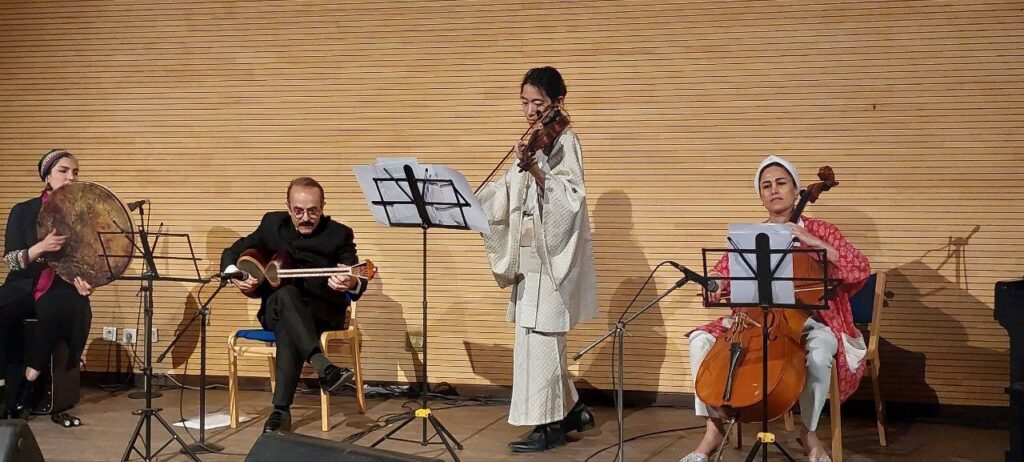Tehran-The “Melodies of the East” concert, a cultural event featuring the joint artistry of famous Iranian musician Keivan Saket and Japanese violinist Nagayo Tsumuzi, was held on Saturday at the Japanese Embassy in Tehran.
The event, attended by foreign ambassadors and Iranian cultural officials and artists, highlighted the deep-rooted cultural exchange between Iran and Japan.
The event began with comments from Adachi Haydiky, vice minister of Iran’s Japanese Embassy.
Adachi emphasized the concert as evidence of ongoing musical cooperation between the two countries, dating back to Japan’s Nara period 1,300 years ago. He cited the existence of Iranian Sassanid artifacts, including ancient barbat instruments, in Nara Prefecture’s collections as historical evidence of this enduring connection via the Silk Road.
He also expressed his hopes for a continued collaborative music performance in 2029.
The highly acclaimed Iranian Taal and Setar master Keivan Saket shared his intention to carry out his composition “Afsoo” (remorse). He took the opportunity to make it clear that the performance is particularly important while the piece is being performed worldwide in various orchestras.
He dedicated his music to the victims of the recent tragic incident at Bandar Abbas and the victims of the historical atomic bombs in Hiroshima and Nagasaki, emphasizing sharing the human experiences of loss and resilience.
“Given that we are all saddened by the tragic disaster of Bandar Abbas, I dedicate this work to the innocent victims of Bandar Abbas and the victims of Hiroshima and Nagasaki.”
On his side, Tsumzi spoke about his first visit to Iran. He explained that he was in the country to record a new music video with the support of Iran’s Arts Bureau, an Islamic Ideology Promotion Organization.
The Tsunami expressed his gratitude to Payman Saadat, the Iranian ambassador to Japan for promoting his trip.
Inspired by online images and the beauty of Isfahan, the tsunami revealed that he had composed a piece entitled “Cloudy Isfahan,” where he is currently filming the music video. He will also record a video of his work “Caravan,” inspired by the desert caravan salai.
The Japanese violinist praised the support of the Art Bureau and the Iranian ambassador to meet his long-standing desire to visit Iran.
He also spoke about his recent six-day journey to cities of Tehran, Isfahan, Kashan, Valzane and Shiraz in a group of six mixed Iranian and Japanese.
He highlighted successful collaborations during the video shoot process, saying that the group overcame national differences in order to complete their work. He emphasized that this journey will deepen mutual understanding of history and culture and position Iran and Japan as potential partners for its ancient heritage, believing that “a country with a deep history is doing well.”
He also spoke of the “amazing” and “Japan-friendly” feeling he met with people who wanted to take photos with him. This positive image and friendly relations between the two countries were sources of joy, and he vowed to expand these ties further and return to experiencing “parallel hospitality.”
The concert featured a repertoire of ten music co-composed by Sackett and Tsunami. They were accompanied by a group of Iranian musicians, including DAF players and percussionist Negar Eizaji, tonback player Siabassaket, cellist Raha Sajedi and pianist Parizad Zeigami.
The concert concluded with a symbolic performance of the Japanese national anthem and beloved Iranian work “Ai Iran” (“o Iran”), highlighting the unification and friendship between the two countries through the universal language of music.
sab/

